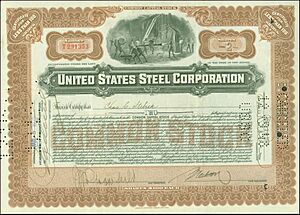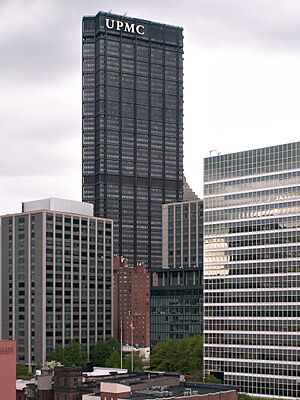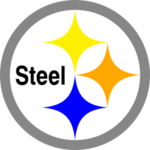U.S. Steel facts for kids
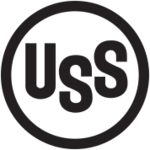
Logo used since 1958
|
|
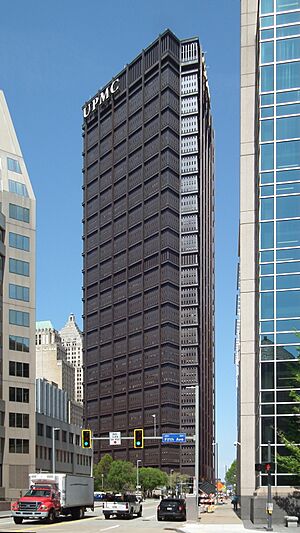
The U.S. Steel Tower in Pittsburgh, the company's headquarters.
|
|
|
Formerly
|
USX Corporation (1986–2001) |
|---|---|
| Subsidiary | |
| Traded as |
|
| Industry | Steel |
| Founded | March 2, 1901 |
| Founders |
|
| Headquarters | U.S. Steel Tower,
Pittsburgh, Pennsylvania
,
United States
|
|
Area served
|
Worldwide |
|
Key people
|
|
| Products | Steel for cars, buildings, and appliances |
| Revenue | |
|
Operating income
|
|
| Total assets | |
| Total equity | |
| Owner | Nippon Steel (100%) |
|
Number of employees
|
22,053 (2024) |
The United States Steel Corporation, often called U.S. Steel, is a famous American company that makes steel. For over a century, it has produced the strong metal used in everything from skyscrapers and bridges to cars and refrigerators. The company is based in Pittsburgh, Pennsylvania, and has factories across the United States and in Europe.
U.S. Steel makes different types of steel products for many industries, including construction, cars, and energy. It also has its own facilities to produce iron ore and coke, which are key ingredients for making steel.
For a long time, U.S. Steel was the biggest steel producer in the world. While it's not the largest globally anymore, it remains one of the top steelmakers in the United States.
In 2025, U.S. Steel was bought by Nippon Steel, Japan's largest steel producer, for $14.9 billion. The deal was controversial and involved discussions with U.S. presidents and labor unions. However, the company kept its name and its headquarters in Pittsburgh.
Contents
The Story of U.S. Steel
A Giant is Born (Early 1900s)
U.S. Steel was formed in 1901 when the famous banker J. P. Morgan merged several steel companies, including Andrew Carnegie's Carnegie Steel. The new company was gigantic. It was capitalized at $1.4 billion, making it the world's first-ever billion-dollar corporation.
In its first year, U.S. Steel made about two-thirds of all the steel produced in the United States. It was so large and powerful that people on Wall Street simply called it "The Corporation."
The company's first president was Charles M. Schwab, who had worked for Andrew Carnegie and helped organize the merger.
In 1907, U.S. Steel bought its biggest competitor, the Tennessee Coal, Iron and Railroad Company. A year later, the company started the "Safety First" movement to make its factories safer for workers.
Challenges and Changes
The U.S. government worried that U.S. Steel was too powerful and might become a monopoly. In 1911, the government tried to break up the company using antitrust laws, but it was not successful.
In the early 20th century, the company's growth in the South involved unfair labor practices. This included using prisoners from local jails, who were forced to work in harsh conditions. This system, known as convict leasing, was a sad part of American history that affected many companies at the time.
During World War II, U.S. Steel played a vital role by producing huge amounts of steel for ships, tanks, and weapons. In 1943, the company had more than 340,000 employees.
After the war, the U.S. government sometimes clashed with the company. In 1952, President Harry S. Truman tried to take control of the steel mills during a strike, but the Supreme Court said he couldn't. In 1962, President John F. Kennedy successfully pressured the company to not raise its prices.
Difficult Times and New Directions (Late 1900s)
Starting in the 1970s, the American steel industry faced tough competition from other countries. To stay profitable, U.S. Steel began to diversify. In 1982, it bought Marathon Oil, a large energy company.
To reflect its new focus on both steel and energy, the company changed its name to USX Corporation in 1986.
That same year, a major labor dispute led to about 22,000 workers stopping work for six months. This was a difficult time for both the company and its employees.
A New Century, A New Focus
In 2001, USX decided to focus on steel again. It spun off Marathon Oil into a separate company and changed its name back to U.S. Steel.
The company began looking for new opportunities. It bought steel plants in Slovakia and Serbia and invested in modern technology. In 2019, U.S. Steel bought a large share of Big River Steel in Arkansas, a new and highly advanced mill. By 2021, it owned the entire company. This showed a shift toward more efficient and environmentally friendly steelmaking.
A New Chapter: The Nippon Steel Deal
On December 18, 2023, Japan's largest steelmaker, Nippon Steel, announced it wanted to buy U.S. Steel for $14.9 billion. Nippon Steel promised to keep the U.S. Steel name and its headquarters in Pittsburgh.
A National Debate
The proposed sale caused a lot of debate. The United Steelworkers (USW), the main union for U.S. Steel employees, was against the deal. They worried about jobs and the future of the American steel industry.
The deal also became a political issue. President Joe Biden said that U.S. Steel should remain an American-owned company for national security reasons. He said he would use his power to try and stop the sale. Former President Donald Trump also opposed the deal at first.
The Deal is Done
After months of discussion, the deal was changed to address some of these concerns. In May 2025, President Trump announced a new "planned partnership."
Under the new agreement, Nippon Steel would invest billions in U.S. factories. The U.S. government would also get a "golden share," giving it the power to veto certain decisions to protect national interests.
The acquisition was finalized on June 18, 2025, and U.S. Steel became fully owned by Nippon Steel.
U.S. Steel's Lasting Legacy
U.S. Steel has left its mark on American culture in many ways.
The Steelmark Logo and the Steelers
U.S. Steel created the "Steelmark" logo to show how important steel is in everyday life. The logo has three diamond shapes (called hypocycloids).
The Pittsburgh Steelers, the city's professional football team, adopted this logo for their helmets in 1962. It's a tribute to Pittsburgh's history as a major center for the steel industry.
Famous Structures
- U.S. Steel Tower: The company's headquarters in Pittsburgh is the tallest skyscraper in the city. It was built using the company's own Corten steel, which creates a protective rust-like layer.
- Unisphere: For the 1964 World's Fair in New York, U.S. Steel built the Unisphere. It is a giant, 12-story-high steel globe that became a famous landmark.
- Chicago Picasso: This giant, abstract sculpture in Chicago was built by U.S. Steel in Gary, Indiana, and then moved to the city.
U.S. Steel also sponsored a popular TV show called The United States Steel Hour from 1945 to 1963.
Where is U.S. Steel Made?
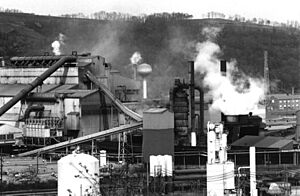
U.S. Steel has factories, called mills, in several states. Some of the most important ones are:
- Mon Valley Works: A group of facilities near Pittsburgh, Pennsylvania, including the Edgar Thomson Works, one of the oldest steel mills in the world.
- Gary Works: Located in Gary, Indiana, this is the company's largest factory and one of the biggest steel mills in North America.
- Big River Steel Works: A new, state-of-the-art facility in Osceola, Arkansas, that uses modern technology to make steel.
The company also has facilities in other countries, such as Slovakia.
Images for kids
See also
 In Spanish: U.S. Steel para niños
In Spanish: U.S. Steel para niños
- History of the steel industry (1850–1970)
- Iron and steel industry in the United States
- Weathering steel


